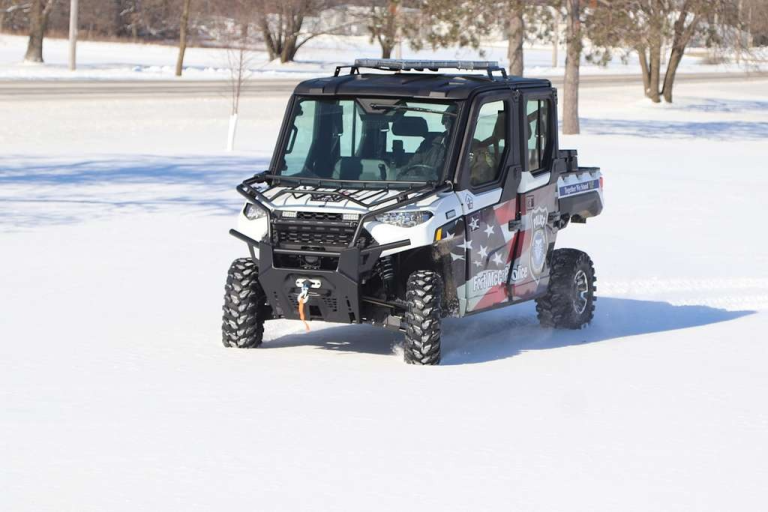If you’ve ever wondered whether you can ride your four-wheeler from the trailhead into town, you’ve probably searched for Florida ATV Street Legal guidance and ended up buried in jargon. This guide translates the legalese into plain English, walks you through what’s allowed, where it’s allowed, and how to stay on the right side of the rules, without draining your wallet.
Need help with titles, plates, and OHV paperwork while sorting out Florida ATV Street Legal rules? 1 Dollar Montana is an all types of vehicle registration company. They simplify forms, deadlines, and compliance so you can ride safer and prepared.
Florida is a dream state for off-roaders: endless sunshine, scenic forest roads, and a growing network of OHV (Off-Highway Vehicle) areas. Yet the state’s rules around riding on public roads are nuanced. Many riders also search How to make a UTV street legal in Florida, but the big idea is that ATVs are primarily off-road machines, with only limited circumstances where low-speed, daylight-only, and signage-backed roadway travel is allowed.
Understanding the difference between “street legal” and “street permissible in specific contexts” is the key to stress-free exploring.
What “Florida ATV Street Legal” really means
Let’s cut through the confusion. Across the U.S., the term “street legal” usually means a vehicle meets equipment standards (lights, mirrors, DOT tires, emissions), passes an inspection where required, and can be registered, tagged, and insured for full public-road use like any car or motorcycle. In Florida, an ATV is designated as an off-highway vehicle and, by default, is not intended for general roadway travel. However, Florida law—and local ordinances—carve out exceptions for certain roads, speeds, and times, particularly in rural counties.
Think of it as a permission-based system:
- Where permitted by local rule, an ATV may cross or briefly use specific roads.
- Equipment requirements are narrower than full vehicle “street legal” standards, but safety features still matter (headlight, taillight, sometimes a flag or reflectors).
- Road type and posted speed limits shape what you can do. Low-speed streets and designated crossings are your friends.
- Age, licensing, and safety gear rules apply, especially for riders under 16 (helmets!) and for anyone traveling at dusk or night (lighting!).
So, while it’s common to hear riders talk about making a quad “street legal,” the Florida reality is closer to “qualified, conditional access.” Treat the phrase Florida ATV Street Legal as shorthand for “legal on certain streets under certain rules.”
The three zones of legality: trails, transitions, and towns
To plan a day without roadside surprises, visualize your ride in three zones:
- Trails (Green Zone)
Public OHV areas and private parks are your safest bet. Permits, helmets, spark arrestors, and noise rules may apply. In this zone, your ATV is in its natural habitat. Know each site’s rules and carry your permit or day pass. - Transitions (Yellow Zone)
These are designated or local-ordinance roads that permit ATV use at low speeds, often to connect trail networks, campgrounds, or fuel stops. Here’s where you rely on signage, local county rules, and time-of-day limits. Keep speeds down, lights on, and your route pre-planned. - Towns (Red Zone)
Most Florida cities and towns don’t allow general ATV operation on public streets. Some rural communities adopt special rules, but urban/suburban cores are typically off-limits. Assume “no” unless a county/city specifically says “yes” and the street’s posted speed limit fits within the rules.
Equipment & documentation checklist (your “no-tow” insurance)
Even in the most permissive counties, you’ll want to prep your machine and paperwork. Use this checklist as a baseline and confirm local requirements before rolling out:
Safety & visibility
- Headlight (functioning on low beam) and taillight/brake light if you’ll be near dusk.
- Reflectors on the rear or a tall safety flag are required in OHV areas where required.
- A horn or signaling device (not always required, but helpful for mixed traffic).
- Rearview mirror for situational awareness (again, often recommended even if not mandated).
- Proper tires with adequate tread; some areas require low-pressure off-road tires only on dirt (check signage if crossing pavement).
Rider gear
- A DOT-compliant helmet for riders under 16 is commonly required; smart for everyone.
- Eye protection (goggles or visor), gloves, over-the-ankle boots, and long sleeves.
Paperwork
- Proof of ownership/registration where applicable (Florida uses OHV registration for state-managed trails; counties may ask for proof if you’re on designated connectors).
- Proof of age for youth riders and any completed safety course certificates.
- If your route crosses private land, written permission from the owner.
Machine condition
- Functional brakes (front/rear), throttle return, and steering free of play.
- Spark arrestor for public lands that require it.
- Reasonable sound level; loud pipes can trigger enforcement—even where access is allowed.
Pro tip: Assemble a slim “compliance pouch” with copies of your registration or permit, ID, county ordinance printouts/screenshots, and emergency contacts. A little organization goes a long way when you meet a ranger or deputy on a connector road.
County-by-county: the rule of local control
Florida’s statewide statutes set the foundation, but local governments decide where ATVs can touch pavement. That means two neighboring counties can have very different allowances. Before you plan a connector ride:
- Search the county code (or call the county sheriff or parks department). Ask specifically about ATV operation on county roads, maximum posted speeds allowed, crossing rules, and daylight restrictions.
- Verify signage at trailheads and road junctions. Signs often govern the exact move you want to make—crossing, right turn only, or “no ATVs beyond this point.”
- Note that school zones, main arterials, and state highways are commonly off-limits. Even if a county allows some ATV travel, those big roads usually remain a hard no.
Because local control is king, your route plan matters almost as much as your machine setup. Pre-ride e-scouting, Google Maps satellite view plus county GIS maps, pays off.
Insurance, liability, and common-sense riding
Even if nobody asks for it, liability coverage is smart. ATVs mix poorly with traffic; your risk is higher when you leave the trail. If you trailer to your riding area, review your auto policy for cargo coverage, then consider a standalone OHV policy that covers:
- Bodily injury and property damage.
- Uninsured/underinsured motorists (especially around rural roads).
- Medical payments for you and your passenger.
- Accessory coverage (winch, lighting, racks).
Keep your risk profile down:
- Ride single file on the shoulder if allowed, at a pace that would not surprise a car backing from a driveway.
- Use hand signals and give a wide berth to pedestrians and cyclists.
- Don’t assume drivers see you—small vehicles disappear in mirrors.
Can you “convert” an ATV to be fully street legal in Florida?
This is the most misunderstood question. In many states, “dual-sporting” a dirt bike or tagging a UTV through special inspections is possible. In Florida, ATVs are categorized for off-highway use; getting them titled and insured as fully road-going vehicles like motorcycles is generally not the pathway.
What you can do is set up your ATV with prudent safety gear and use it where and when local rules permit limited roadway operation. That’s why knowing the phrase Florida ATV Street Legal in context is more about where and how you ride than about converting your quad into a car replacement.
If you truly need road-capable utility, consider:
- A side-by-side that meets local “low-speed vehicle” (LSV) standards (different from ATV classification).
- A small displacement dual-sport motorcycle with a factory plate.
- A dedicated trailer + truck combo to bridge non-permissive road segments.
Route planning: try this three-layer approach
- Primary OHV area selection
Pick your core riding zone—Ocala National Forest trail systems, state forests with OHV loops, or private parks. Confirm hours, fees, and vehicle types allowed. - Connector mapping
Identify fuel, food, and scenic connectors you want to ride, then overlay county ordinances and posted speed limits. Eliminate any segments that exceed local allowances. - Contingency access
Mark bail-out points, legal parking lots for reloading onto a trailer, and alternate off-street paths (graded forest roads open to OHV travel). If an unexpected sign blocks a connector, your day isn’t ruined.
Youth riders and family groups
Florida welcomes family riding, but minors come with extra responsibilities:
- Helmets are non-negotiable for riders under 16, and they should be DOT-certified.
- Supervision is expected. Keep kids within sight and ride at their pace.
- Education pays: a short OHV safety course (many are online) teaches hand signals, braking on loose surfaces, and the “look, listen, and roll” approach to road crossings.
- Size and power matter: match machine displacement to the rider’s size and skill. Over-biked kids make mistakes; under-biked riders can’t keep pace safely in traffic-adjacent connectors.
Trail etiquette that influences road access
Public perception shapes policy. Courteous trail manners often translate to more connector permissions down the line:
- Stay on designated routes; don’t cut switchbacks or widen trails.
- Slow-roll near homes and campsites; dust control is neighbor diplomacy.
- Pack out trash and secure your load so nothing flies off at speed.
- Yield wisely: hikers and horses get priority; stop, shut down, and let mounted riders pass calmly.
If riders as a group keep noise and conflicts low, county commissioners hear fewer complaints—and are more likely to maintain or expand ATV-friendly connectors.
Quick myths vs. facts
- Myth: “If I bolt on turn signals and mirrors, I’m street legal anywhere.”
Fact: Equipment helps, but permission rules the day in Florida. - Myth: “I can ride the shoulder of any rural road.”
Fact: Only where the county says you can—and speed limits and times may apply. - Myth: “Insurance isn’t necessary because I’m off-road.”
Fact: The moment you touch a shared road—or even a parking lot—liability exposure increases.
A practical pre-ride template you can copy
The night before:
- Check the forecast, pack layers, charge comms, and GPS.
- Print or save PDFs of the county’s ATV ordinances and your OHV permits.
- Inspect brakes, throttle, tires, and lights; tighten rack and winch hardware.
At the trailhead:
- Review the map with your group; confirm who leads and who sweeps.
- Align on hand signals and radio channels.
- Note the time—many connector allowances are daylight only.
On the move:
- Ride predictably, signal early, wave courteously at locals.
- Adjust spacing for dust and visibility; don’t stack up at crossings.
- If conditions change (signage, closures), reroute without debate.
Why the wording matters—and how to communicate with officers
Language can de-escalate. If you’re stopped, clarity helps:
- “Officer, we planned a route based on the county ordinance that permits low-speed ATV use on this segment.”
- “We’re headed to the fuel stop and then returning to the OHV loop.”
- “Here’s our printed ordinance and our permits.”
You’re demonstrating intent to comply, not to “beat the system.” That tone can mean the difference between a warning and a citation.
Final words
Navigating Florida ATV Street Legal realities is about preparation, local knowledge, and respectful riding. Florida rewards riders who treat roads as short connectors, not racetracks, and who back up their adventures with the right gear, documents, and the right attitude.
Plan your loop, verify your county rules, and build a small safety margin into every decision, time, speed, and space. Before the trip, lock down Florida ATV Street Legal essentials without stress.

